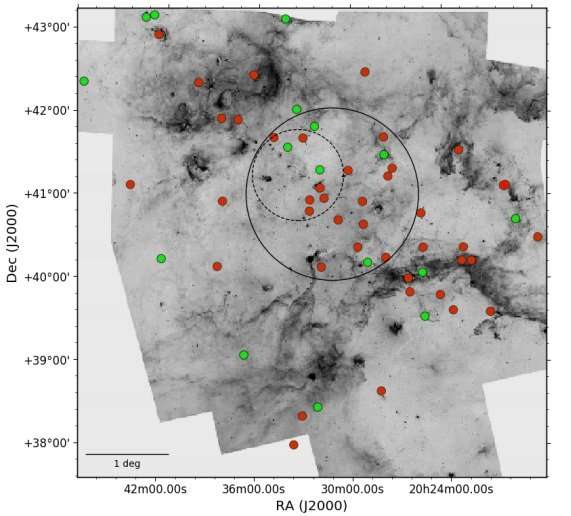Inverse Spitzer 8 µm image of the Cygnus region showing the location of the 61 OB candidates. The 42 confirmed massive OB-type stars earlier than B3 are indicated with red dots. The remaining stars are late B and foreground A-F-G stars which are indicated with green dots. The solid line circle delimits the 1 degree radius area of Cygnus OB2 adopted by Comerón & Pasquali (2012). For reference, the dash-dotted line circle shows the area considered by Wright et al. (2015). Credit: Berlanas et al., 2017.
(Phys.org)—European astronomers have identified 42 new massive members of the Cygnus OB2 stellar association. The discovery increases the young massive population known in this association. The findings were presented November 19 in a paper published online on the arXiv pre-print repository.
Located some 4,700 light years away from the Earth, Cygnus OB2 is the richest association of stars of spectral class O and B. It is associated with one of the most powerful star-forming regions, known as Cygnus complex.
Cygnus OB2 offers a large homogeneous population of OB stars that can be analyzed by astronomers. However, although many studies of this association have been performed in the past, the census of its OB stars is still incomplete.
A team of astronomers from Spain and Germany decided to change this by updating the number of OB-type stars in Cygnus OB2. The group, led by Sara Rodriguez Berlanas of the University of La Laguna on the island of Tenerife, Canary Islands, Spain, conducted an intermediate resolution spectroscopic observational campaign of Cygnus OB2 between 2013 and 2017. They observed more than 60 candidates, and classified 42 of them as new OB-type stars.
"From the whole sample of 61 candidates, we have classified 42 stars as new massive OB-type stars, earlier than B3, in Cygnus OB2 and surroundings, including 11 O-type stars," the paper reads.
According to the study, 30 of the newly detected stars have spectral types of B0 and B1, while only one is a B2 star. When it comes to 11 newly found O-type stars, one of them is an O6 star and the rest has spectral types ranging from O7 to O9. The remaining 19 candidates were identified as A, F and G-type stars, as well as late B-type stars.
The researchers noted that 16 of the 42 new OB-stars were found in the OB2 association, while the rest resides in its surroundings.
The astronomers confirm that two stars in the sample, designated J20272099+4121262 and HD228973, are binaries. Moreover, another seven are possible binaries that require further observations in order to confirm their binary nature. The study also reveals that the hottest stars among the new OB star is J20423509+4256364 with an effective temperature of 38,192 K and the most luminous one is J20395358+4222506.
Although the research identified a relatively large number of new members of Cygnus OB2, more observations are required to complete the census of early-type stars in this stellar association.
In concluding remarks, the authors added that many O and early B stars at B-band magnitudes above 16 are still undiscovered in this association.
More information: New massive members of Cygnus OB2, arXiv:1711.06945 [astro-ph.SR] arxiv.org/abs/1711.06945
Abstract
The Cygnus complex is one of the most powerful star forming regions at a close distance from the Sun (~1.4 kpc). Its richest OB association Cygnus OB2 is known to harbour many tens of O-type stars and hundreds of B-type stars, providing a large homogeneous population of OB stars that can be analysed. Many studies of its massive population have been developed in the last decades, although the total number of OB stars is still incomplete. We have obtained new blue intermediate-resolution spectra suitable for spectral classification of the 61 candidates presented by Comer'on & Pasquali (2012) in Cygnus OB2 and surroundings. We thus performed a spectral classification of the sample using He I-II and metal lines rates, as well as the Marxist Ghost Buster (MGB) software for O-type stars and the IACOB standards catalogue for B-type stars. Out of the 61 candidates, we have classified 42 stars as new massive OB-type stars, earlier than B3, in Cygnus OB2 and surroundings, including 11 O-type stars. The other candidates are discarded as they display later spectral types inconsistent with membership in the association. However, the magnitude cutoff and dust extinction introduce an incompleteness. Many O and early B stars at B > 16 mag are still undiscovered in the region. Finally, we have studied the age and extinction distribution of our sample within the region, placing them in the Hertzsprung-Russell Diagram using both rotating and non-rotating models calculated by Ekstr"om et al. (2012) and Brott et al. (2011) in order to assess age uncertainties. Massive star formation in Cygnus OB2 seems to have proceeded from lower to higher Galactic longitudes, regardless of the details of the models used. The correlation between age and Galactic longitude previously found in the region is now confirmed.
© 2017 Phys.org
























